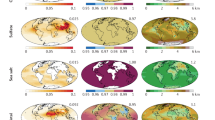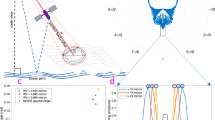Abstract
LINEAR polarization of clear daytime sky and twilight is produced by molecular (Rayleigh) scattering and aerosol (Mie) scattering, which predominates in the infrared. Incident linearly polarized light scattered by aerosols is in general elliptically polarized, whereas no ellipticity can arise from the molecular component1. The principal component of clear daytime sky arises from single scattering of unpolarized sunlight and is not elliptically polarized. However, whenever multiple scattering by the aerosol component is important, the strong linear polarization produced on the first scattering will lead to elliptical polarization from the second and subsequent scatterings. Although in the daytime sky this mechanism should give only a small ellipticity2 (10−5–10−3) the possibility of a substantially larger effect at twilight arises because there is no direct illumination. We report here observations of circular polarization of twilight of order 10−3.
This is a preview of subscription content, access via your institution
Access options
Subscribe to this journal
Receive 51 print issues and online access
$199.00 per year
only $3.90 per issue
Buy this article
- Purchase on Springer Link
- Instant access to full article PDF
Prices may be subject to local taxes which are calculated during checkout
Similar content being viewed by others
References
Van de Hulst, H. C., Light Scattering by Small Particles (Wiley, 1957).
Hansen, J. E., J. Atmos. Sci., 28, 15 (1971).
Angel, J. R. P., and Landstreet, J. D., Astrophys. J. Lett., 162, L61 (1970).
Landstreet, J. D., and Angel, J. R. P., Astrophys. J. (in the press).
Hansen, J. E., Feasibility of Monitoring Particulate Air Pollution from Satellites, Draft Report for UN (1972).
Rosenberg, G. V., Izv. Akad. Nauk SSR Fiz. Atmos. Okeana, 3, 400 (1967).
Eiden, R., App. Opt., 5, 569 (1966).
Kemp, J. C., Wolstencroft, R. D., and Swedlund, J. B., Nature, 232, 165 (1971).
Gehrels, T., Astrophys. J. Lett., 173, L23 (1972).
Martin, P. G., Mon. Not. Roy. Astron. Soc. (in the press).
Author information
Authors and Affiliations
Rights and permissions
About this article
Cite this article
ANGEL, J., ILLING, R. & MARTIN, P. Physical Sciences: Circular Polarization of Twilight. Nature 238, 389–390 (1972). https://doi.org/10.1038/238389a0
Received:
Issue Date:
DOI: https://doi.org/10.1038/238389a0
This article is cited by
-
A mechanism for molecular asymmetry
Journal of Molecular Evolution (1991)
-
The origin and amplification of biomolecular chirality
Origins of life and evolution of the biosphere (1991)
-
Weak neutral currents and the origin of biomolecular chirality
Nature (1985)
-
Origins of biomolecular handedness
Nature (1984)
-
β Decay and the origins of biological chirality: experimental results
Nature (1982)
Comments
By submitting a comment you agree to abide by our Terms and Community Guidelines. If you find something abusive or that does not comply with our terms or guidelines please flag it as inappropriate.



